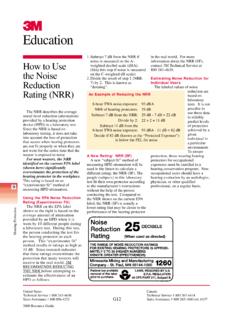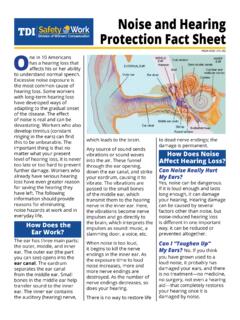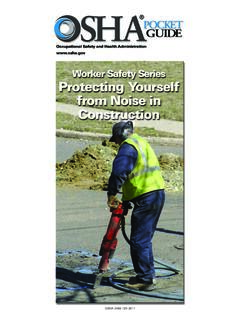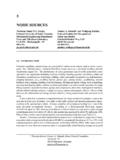Transcription of NIOSH Sound Level Meter Application (app) for iOS devices
1 1 NIOSH Sound Level Meter Application (app) for iOS devices hearing Loss Prevention Team Engineering and Physical Hazards Branch Division of Applied Research and Technology Developed in collaboration by EA LAB, Inc. under MOU agreement between NIOSH and EA LAB 2 Table of Contents Why did NIOSH develop this app? ..3 Does this app comply with ANSI or IEC Sound Level Meter or noise dosimeter standards? ..5 Main Screen ( Sound Level Meter ) ..6 What are the main features of the NIOSH SLM app? ..7 Saved measurements screen .. 10 noise info screen .. 12 a. What noises can cause hearing disorders .. 13 b. How to prevent hearing loss .. 14 c. How to conduct a noise survey .. 15 d. How to select proper hearing protection .. 17 Settings Screen .. 20 NIOSH smartphone studies .. 28 3 Why did NIOSH develop this app?
2 NIOSH estimates that 22 million workers are exposed to hazardous noise levels every year. In addition to damaging workers quality of life, occupational hearing loss carries a high economic price to society. The NIOSH hearing loss team evaluated 192 Sound measurement applications (apps) for the iOS and Android platforms to examine their suitability and accuracy in relation to professional Sound measurement instruments. Of the 192 apps, 10 iOS apps met our selection criteria for functionality, features, and calibration capability, and only 4 apps met our accuracy criteria of ( 2 dB(A) mean difference from the reference type 1 Sound Level Meter ). The results were published in the Journal of Acoustical Society of America (JASA): Evaluation of smartphone Sound measurement applications , Kardous and Shaw 2014.
3 A followup study on the use of smartphone with external microphones was published in JASA in 2016 (Evaluation of smartphone Sound measurement applications (apps) using external microphones A follow-up study, Kardous and Shaw 2016), the study revealed that apps used with external calibrated microphones show close agreement with Type 1 Sound Level Meter (accuracy within 1 dB(A) of reference type 1 Sound Level Meter . The studies also revealed that most commercially available Sound measurement apps lacked the accuracy and functionality necessary to conduct occupational and general-purpose noise measurements. As a result, NIOSH hearing loss researchers collaborated with one of the 4 app developers to develop a free Sound measurement app that can be distributed to the occupational safety and health community as well as the general public.)
4 NIOSH signed an MOU agreement with EA LAB in February 2015 to develop the NIOSH Sound Level Meter app. The app was subjected to the same testing requirements that were established in the Kardous and Shaw studies. The ubiquity of smartphones and the sophistication of current Sound measurement applications present a great opportunity to revolutionize current data collection and surveillance practices for noise . Through the use of crowdsourcing techniques, workers around the world may be able to collect and share workplace (or task-based) noise exposure data using their smartphones. Scientists and occupational safety and health professionals can rely on such shared data to build job exposure databases and promote better hearing health and prevention efforts. In addition, the ability to acquire and display real-time noise exposure data raises workers awareness about their work (and off-work) environment and allows them to make informed decisions about hazards to their hearing .
5 A NIOSH -developed and branded occupational Sound measurement smartphone app will help advance the NIOSH mission by translating knowledge of occupational Sound measurement into a practical and informational product that will be available to more than billion active iOS devices worldwide. 4 Figure 1. The main screen of the NIOSH SLM app (shown with an external microphone on iPhone 8) 5 Does this app comply with ANSI or IEC Sound Level Meter or noise dosimeter standards? Professional Sound Level meters (SLMs) must comply with national and international standards such as the American National Standards Institute (ANSI) ), Specifications for Sound Level meters and International Electrotechnical Commission (IEC) 61672, Sound Level meters : Specifications (ANSI adopted the IEC standard in 2014). ANSI/IEC standards specify acoustical, electrical, and environmental tests with indicated tolerance limits and measurement uncertainties that are specified in decibels over a wide frequency range (typically from 10 Hz 20 kHz).
6 Such tests must account for Level linearity, directionality, time and frequency-weighting responses, tone bursts, radio frequency interference, and atmospheric and environmental conditions. The standards also specify that these tests shall be made on the complete instrument, including the microphone and pre-amplifier. In 2018, EA LAB and NIOSH researchers evaluated the app s performance as part of a system (iPhone + external microphone) for compliance with type 2 requirements of IEC 61672/ANSI standard: Sound Level meters Part 3: Periodic Tests. The results were published in the Applied Acoustics Journal [Celestina et al. 2018]. Celestina, M., Hrovat, J., & Kardous, C. A. (2018). Smartphone-based Sound Level measurement apps: Evaluation of compliance with international Sound Level Meter standards. Applied Acoustics, 139, 119-128.
7 NIOSH and EA LAB continue to work towards achieving compliance with Part 1 and 2 or IEC 61672, but as of today, this is the only app that has shown any compliance with Sound Level meters standards. This app is meant to serve as a practical tool to raise awareness about noise levels in the workplace. Increased awareness could lead workers and managers to request full professional noise surveys and implement engineering controls or hearing conservation programs to reduce the risk of noise -induced hearing loss. 6 Main Screen ( Sound Level Meter ) Once the user launches the app, they will be presented with a main screen (dB icon highlighted on the bottom left corner). The top half of the screen shows a readout of the Sound Level using the built-in microphone (or external microphone if used) and reports the instantaneous Sound Level in A, C, or Z-weighted decibels.
8 The weighting is user-selectable and can be accessed in the Settings screen. 7 What are the main features of the NIOSH SLM app? The NIOSH Sound Level Meter app has many important features: it provides a readout of the Sound Level using the built-in microphone (or with an external microphone) and reports the instantaneous Sound Level in A, C, or Z-weighted decibels. The weighting is user-selectable and can be accessed in the Settings screen. The app also reports the main metrics that are important for proper occupational noise measurements: run time (total time), A-weighted equivalent Sound Level (LAeq), maximum Level measured during the current run time, C-weighted peak Sound pressure Level (LCpeak), time-weighted average (TWA), and dose. The app also contains basic information about noise and hearing loss prevention.
9 In addition, the app allows the user to save and share measurement data using the smartphone other communication and media features. If location services are enabled, the app can use the GPS feature to provide an exact geospatial location of the location of the noise measurement. Total run time: Total run time for the current measurement Instantaneous Level : Default Sound pressure Level in A, C, or Z-weighted decibels [dB(A), dB(C), dB(Z)]. LAeq: Equivalent (averaged every second) continuous Sound Level in A-weighted decibels [dB(A)]. Max Level : Highest Sound pressure Level during a measurement period. LCpeak: Peak Sound pressure Level in C-weighted decibels [dB(C)]. TWA: Time-weighted average is the Sound Level accumulated over any time period, but with its average computed over an 8-hour time period.
10 Dose: A percentage of the maximum allowable daily noise dose. Exposures at 100% or above are considered hazardous. Projected Dose: The current noise dose, over the current measurement duration, projected forward over 8 hours (assuming the Sound Level remains constant over that same 8-hour period) On the bottom of the screen, there are five major buttons: Start, Pause, and Reset: The app will give the user a warning before reset, Save, and Upload (through email)). A permanent bar at the bottom of the screen allows the user to switch between the main 4 screens of the app Soundlevelmeter (dB), Saved, noise info, and Settings. The user can toggle back and forth between these screens and can also use the button at the top left of the screen to go back to the previous screen. 8 There is a help button that the user can select to get more information about the specific screen: 9 How to interpret the results or readouts of the app NIOSH establishes recommended exposure limits (REL) for various hazards on the basis of the best available science and practice.

















